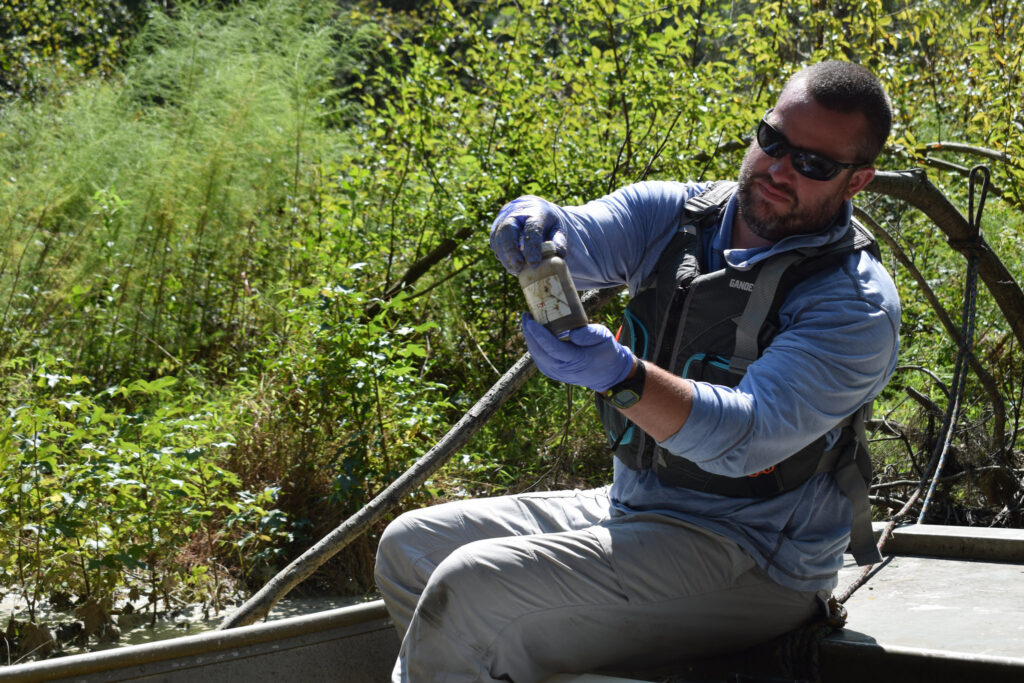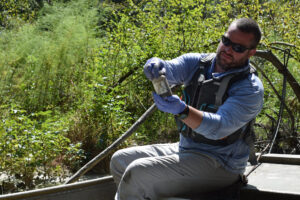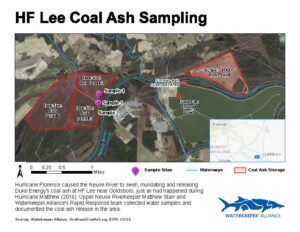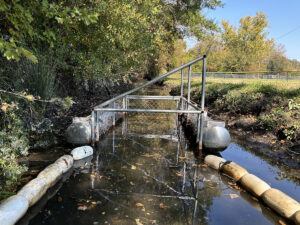News
High levels of arsenic found in Neuse River following H.F. Lee Coal Ash Spill
Environmental, Neuse River Watershed, Press Release, Water Quality
Posted on September 28th, 2018
Upper Neuse Riverkeeper conducting post storm water sampling
FOR IMMEDIATE RELEASE
September 28, 2018
Contact:
Matthew Starr, Upper Neuse Riverkeeper, upperneuserk@soundrivers.org , ( 919) 961-2240
Maia Raposo, Waterkeeper Alliance, mraposo@waterkeeper.org , (203) 824-2229
Donna Lisenby, Waterkeeper Alliance, dlisenby@waterkeeper.org , (828) 297-3777
Analysis Finds Toxic Levels of Arsenic in Neuse River Water Following H.F. Lee Coal Ash Spill

Goldsboro, NC – Water sampling of the Neuse River conducted on behalf of the Upper Neuse Riverkeeper and Waterkeeper Alliance following the coal ash spill at Duke Energy’s retired H.F. Lee Plant found levels of arsenic nearly 18 times higher than the North Carolina standard for drinking water supply and fish consumption.
The standard for drinking water supply and fish consumption is 10 micrograms per liter; testing from water sampled from the Neuse near the coal ash spills following Hurricane Florence was 186 micrograms per liter. The city of Goldsboro has a municipal water intake less than ten miles downstream from the plant.
The analysis, conducted by Pace Analytical, also found elevated levels of lead and other heavy metals in the water. That analysis can be found here.
The sample with the highest arsenic level came from a grey plume of ash in the river, which had poured over an actively eroding dam made of coal ash.
“Duke Energy continues to poison the Neuse River, while hiding behind water samples they collected six miles downstream from the inactive ash basins,” said Upper Neuse Riverkeeper Matthew Starr. “Our sample results, collected where the spill into the Neuse was happening, show that Duke could care less about reporting the truth and will continue to mislead the public until they are taken to task by Waterkeeper Alliance and Waterkeeper Organizations. The levels of arsenic that Duke has dumped into the Neuse through its continued mismanagement of its coal ash are alarming, and every time that Duke misleads the public about the true impact of its coal ash, they put our environment and communities at risk. North Carolinians deserve for Duke Energy to tell the truth and for the North Carolina Department of Environmental Quality to hold them accountable.”
The lab analyzed two water samples and two coal ash samples from the flooded Neuse River. Upper Neuse Riverkeeper Matthew Starr collected the samples from a boat on the Neuse Wednesday, Sept. 19. 
“It is very troubling that these ash ponds continue to release toxic pollution that harms aquatic life,” said Donna Lisenby, Waterkeeper Alliance’s manager of global advocacy.
Coal ash is a waste product from coal combustion; it contains heavy metals and other toxic compounds. One million tons of the coal ash stored at H.F. Lee in three inactive ponds were completely submerged by Florence’s floodwaters. Coal ash, the top source of toxic water pollution in the U.S., contains heavy metals such as arsenic, chromium, and mercury.
Duke Energy also sampled the waters of the Neuse, but did so far downstream from the spills. North Carolina’s Department of Environmental Quality documented the spill as the river was receding and collected samples, but has not published its results yet. N.C. DEQ’s photos are here.
Waterkeeper Alliance and Upper Neuse Riverkeeper Matthew Starr discovered a similar coal ash release at H.F. Lee following flooding from Hurricane Matthew in 2016. That leak dumped a one-inch thick layer of coal ash on the Neuse River.
The H.F. Lee plant came online shortly after World War II. The plant, which had three coal-fired units, was retired in 2012. Duke Energy owns 32 coal ash basins in North Carolina, all which are either adjacent to or within a half mile of a river or lake. The North Carolina coal ash ponds contained about 111 million tons of toxic coal ash as of August 2017, according to state estimates. There are more than 1,000 coal ash storage sites around the nation, according to EPA.
Related News

Neuse fish kill expected to extend beyond holiday weekend
July 3rd 2025

Swim Guide fails prompt Maple Cypress investigation
July 3rd 2025

Riverkeeper, town partners root out source of Smithfield sediment pollution
July 3rd 2025

Trash trap No. 12 approved for Smithfield
July 3rd 2025

Sunset River Paddle fundraiser boosts Water Quality Fund
July 3rd 2025

Riverkeepers host quarterly Water Watch meeting
July 3rd 2025

Public hearing will determine the fate of many NC wetlands
June 26th 2025

Clayton gets first official trash-trap cleanout
June 25th 2025

